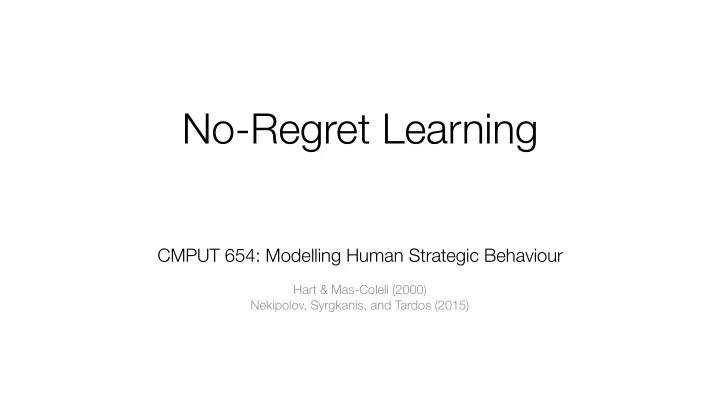

No-Regret Learning CMPUT 654: Modelling Human Strategic Behaviour Hart & Mas-Colell (2000) Nekipolov, Syrgkanis, and Tardos (2015)
Lecture Outline 1. Recap 2. Hart & Mas-Colell (2000) 3. Coarse Correlated Equilibrium 4. Nekipolov, Syrgkanis, and Tardos (2015)
Hart & Mas-Colell (2000) Why: • A no-regret algorithm ( regret matching ) that converges to correlated equilibrium • Influential: This paper is always cited in this area 1. Defines regret matching algorithm and argues for its plausibility 2. Proves that it converges to correlated equilibrium
Correlated Equilibrium Definition: Given an n -agent game G=(N,A,u), a correlated equilibrium is a tuple ( v , π , σ ), where v = ( v 1 , …, v n ) is a tuple of random variables with domains ( D 1 , …, D n ), • π is a joint distribution over v , • σ = ( σ 1 , …, σ n ) is a vector of mappings σ i : D i → A i , and • • for every agent i and mapping σ ′ � i : D i → A i , ∑ ∑ π ( d ) u i ( σ 1 ( d 1 ), …, σ n ( d n )) ≥ π ( d ) u i ( σ 1 ( d 1 ), …, σ ′ � i ( d i ), …, σ n ( d n )) d ∈ D 1 ×⋯× D n d ∈ D 1 ×⋯× D n
Correlated Equilibrium (simplified) Definition: Given an n -agent game G =( N,A,u ), a correlated equilibrium is a distribution 𝜏 ∈ 𝛦 (A) such that for every i ∈ N and actions a ʹ i , a ʹʹ i ∈ A i , ∑ σ ( a )[ u i ( a ′ � ′ � i , a − i ) − u i ( a )] ≤ 0 a ∈ A : a i = a ′ � i
Repeated Setting • A game G =( N,A,u ) is played repeatedly over t =1,2,... • At time t , agent i selects action a it • Each agent i receives utility u i ( a t )
Regret Matching • For every pair of strategies j,k , let W i,t (j,k) be the utility that i would have received at time t by playing k instead of j • Unchanged from u i ( a t ) if i didn't play j • D i,t ( j,k ) is the average of W i,t ( j,k ) - u i ( a t ) up until time t • At each time step, each agent chooses between actions with positive D(j,k), where j is the most-recent action , and the most-recent action j
Convergence of Regret Matching Theorem: If all players play according to regret matching, then the empirical distributions of play converge to the set of correlated equilibria.
Coarse Correlated Equilibrium • Instead of getting to replace each action with an arbitrary action, compare to the case where we play a single action: Definition: Given an n -agent game G=(N,A,u), a coarse correlated equilibrium is a distribution 𝜏 ∈ 𝛦 (A) such that for every i ∈ N and action a ʹ i ∈ A i , i , a − i ) − ∑ ∑ σ ( a ) u i ( a ′ � σ ( a ) u i ( a ) ≤ 0 a − i ∈ A − i a ∈ A
Convergence of Multiagent No-Regret Learning Proposition: If every agent plays a no-regret learning algorithm, then the empirical distribution of play will converge to a coarse correlated equilibrium.
Nekipolov, Syrgkanis, and Tardos (2015) Why: Application of a non-equilibrium behavioural rule to econometrics 1. Define rationalizable set NR 2. Prove properties of NR for sponsored search auctions 3. Apply to value estimation
Setting: Sponsored Search • There are k slots • Each agent submits a bid b i • Highest bid gets first slot, etc. • Each agent pays bid of next-highest slot • Payments are per-click rather than per-impression
Problem: Estimating Types • Each agent has a value v i for a click • We want to estimate what those values are, based on bids • Previously: Assume equilibrium • Now: Assume no-regret learning
Rationalizable Set Definition: The rationalizable set NR is the set of pairs ( v i , 𝜁 i ) such that i 's sequence of bids has regret less than 𝜁 i if i 's value is v i .
Data Analysis Claims: 1. Bids are highly shaded (only 60% of value) 2. Almost all accounts have a few keywords with very small error, and others with large error
Epilogue Some questions: 1. Regret matching includes a notion of inertia . How closely related to I-SAW is it? 2. Why do we think that the smallest rationalizable error is the one to use for point estimates?
Recommend
More recommend